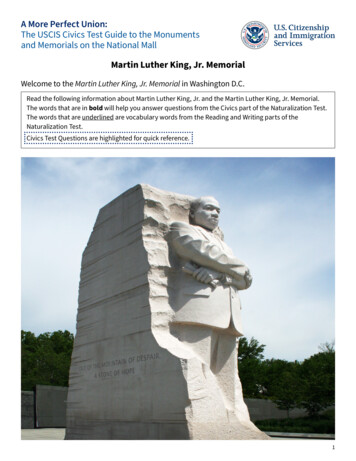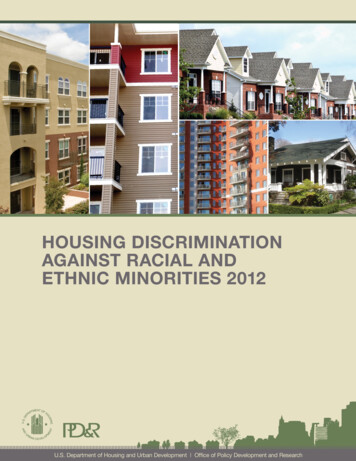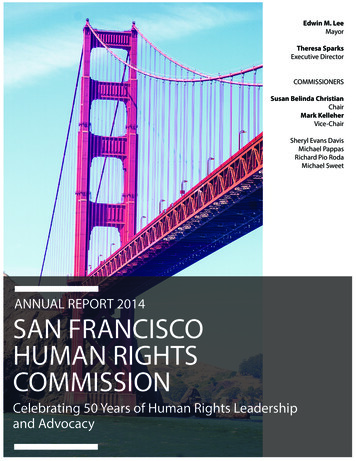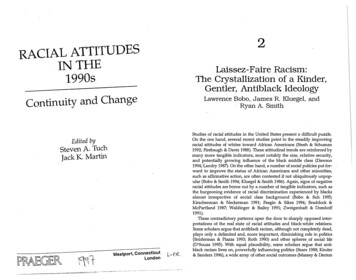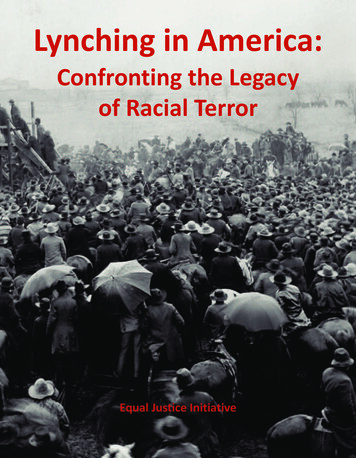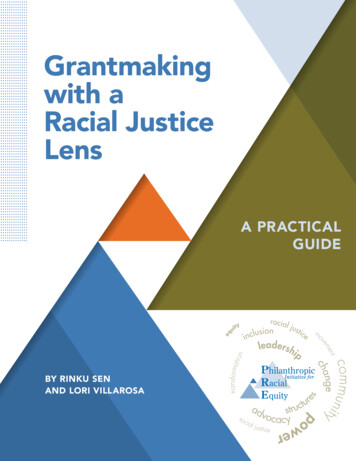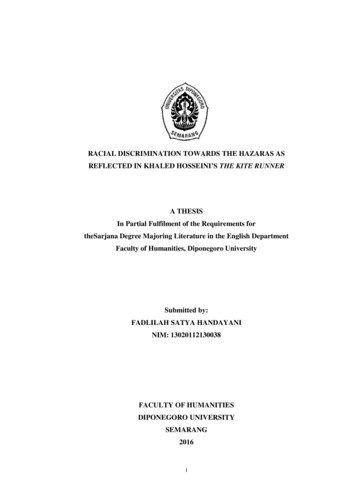
Transcription
RACIAL DISCRIMINATION TOWARDS THE HAZARAS ASREFLECTED IN KHALED HOSSEINI’S THE KITE RUNNERA THESISIn Partial Fulfilment of the Requirements fortheSarjana Degree Majoring Literature in the English DepartmentFaculty of Humanities, Diponegoro UniversitySubmitted by:FADLILAH SATYA HANDAYANINIM: 13020112130038FACULTY OF HUMANITIESDIPONEGORO UNIVERSITYSEMARANG2016i
PRONOUNCEMENTThe writer honestly confirms that she compiles this thesis by herselfwithout taking any results from other researchers in S-1, S-2, S-3, and in diplomadegree of any university. The writer ascertains that she does not quote anymaterial from other publications or someone’s paper except from the referencementioned.Semarang, 25th August 2016FadlilahSatyaHandayaniii
MOTTO AND DEDICATIONMan JaddaWa Jada, whoever strives shall succeed(Negeri 5 Menara)Do the best, be the best and let God do the rest(Anonymous)All our dreams can come true if we have the courage to pursue them(Walt Disney)This thesis is dedicated tomy beloved family and fellowswho always give me an endless love and support to accomplish this thesis.iii
iv
v
ACKNOWLEDGMENTThe writer’s deepest gratitude goes to Allah SWT who has given strengthand faith so that this thesis entitled Racial Discrimination towards the Hazaras asReflected in KhaledHosseini’s The Kite Runner came to a completion. On thisoccasion, the writer would like to thank all those people who have helped andcontributed to the completion of this thesis.The writer’s deepest gratitude and appreciation are extended to Mrs EtaFarmaceliaNurulhady, S.S., M.Hum, M.A, as her academic advisor who gave hercontinuous guidance, helpful correction, moral support, advice, and suggestion,without which it was doubtful that this thesis came into completion. The writer’sdeepest gratitude also goes to the following;1. Dr. Redyanto M. Noor, M.Hum, as the Dean of Faculty of Humanities,Diponegoro University.2. Dr. AgusSubiyanto, M.A., as the Head of the English Department of theFaculty of Humanities, Diponegoro University.3. All lecturers of the English Department Diponegoro University. The writerthanks them for the valuable knowledge, guidance, and help during her study atthe university.4. Special thanks to the writer’s parents, Drs TeguhSudarmoko, M.M. andDraEstiHandayani, and the writer’s beloved brother, BagasSamodra, who alwaysgive an endless support for her education both financially and morally. Wordscannot describe how much the writer loves and feels grateful to have them.vi
6. The writer’s beloved boyfriend, Adithya Adam Permana, who alwaysencourages, understands, listens, and loves.7. The writer’s best friends in college, GengAku; NurachniDwi MS,KusumaningrumHerdayanti, AsriNovia, YanlitaFrenty, ShellaAnggraeni, Revina,Finasari, TitisDyah, R. Khatrina, AnessaGunasiwi, Fenita, Haya, thanks forsharing the best laughter. She loves them all.8. To KKN Ngadimulyo friends who have given the priceless moment.9. All fellow friends in the English Department 2012 especially class A andliterature, the writer thanks them for giving amazing days during her study at theuniversity.10. EDSA UNDIP members.11. The writer expresses gratitude for all related people who always support thewriter to complete this thesis.The writer realizes that this thesis is still far from perfection. Therefore, she willbe glad to receive any constructive criticism and recommendation to make thisthesis better. Finally, the writer expects that this thesis will be useful to the readerwho wishes to learn something about racial discrimination especially its causesand impacts to the society.Semarang, 25th August 2016FadlilahSatyaHandayanivii
TABLE OF CONTENTTITLE . iPRONOUNCEMENT . iiMOTTO AND DEDICATION . iiiAPPROVAL . ivVALIDATION .vACKNOWLEDGEMENT . viTABLE OF CONTENTS . viiiABSTRACT . xiCHAPTER IINTRODUCTION .11.1 Background of the Study .11.2 Research Problems .41.3 Objectives of the Study .41.4 Methods of the Study .41.5 Organization of the Thesis .6CHAPTER IIBIOGRAPHY OF KHALED HOSSEINI ANDSYNOPSIS OF THE KITE RUNNER . 82.1 Biography of KhaledHosseini .82.2 Synopsis of The Kite Runner .10CHAPTER IIITHEORETICAL FRAMEWORK .133.1 Intrinsic Elements .13viii
3.1.1 Characters.143.1.2 Settings.153.1.3 Conflicts .163.2 Extrinsic Elements .183.2.1 Racism and Racial Discrimination .183.2.2 The Causes of Racial Discrimination .203.2.3 The Impacts of Racial Discrimination .22CHAPTER HEKHALEDHOSSEINI’S THE KITE RUNNER.244.1 Analysis of Intrinsic Elements .244.1.1 Analysis of Characters .244.1.1.1 Amir .254.1.1.2 Hassan .264.1.1.3 Assef.284.1.2 Analysis of Settings .294.1.2.1 Setting of Place .294.1.2.2 Setting of Time.304.1.2.3 Setting of Social Environment .304.1.3 Analysis of Conflicts.324.2Racial Discrimination towards The Hazaras asReflected in KhaledHosseini’sThe Kite Runner .36ix
4.2.1 Causes of Racial Discrimination as Depicted in TheKite Runner .364.2.2 Examples of Racial Discrimination inThe Kite Runner .414.2.3 Impacts of Racial Discrimination as Depicted in TheKite Runner .45CHAPTER VCONCLUSION .49BIBLIOGRAPHY .52x
AbstractKhaledHosseini’s novel entitled The Kite Runner is an American bestsellernovel that represents racial conflict between the Pashtuns and Hazaras, twodifferent races and ethnics in Afghanistan. The aims of this study are to find outthe causes of racial discrimination, to analyze examples of racial discrimination,and to analyze the impacts of racial discrimination as depicted in The Kite Runner.Sociological approach, psychological approach, and theories on racism and racialdiscrimination are used in this study. The result of this study shows that racialdiscrimination in The Kite Runner is caused by social structural factors and socialpsychological factors. Pashtuns and Hazaras differ in terms of religious beliefs,cultural practices, social status, and physical appearances. Pashtun as the majorityrace and ethnic in Afghanistan is Sunni Moslem while Hazara is Shi’a. Otherreason why the Hazaras have been discriminated by Pashtun is their appearancethat look like Chinese people. The Hazaras are also seen as the weakest andpoorest race in Afghanistan, so that they are easily subjected to be killed, insulted,and tortured by Pashtuns. Moreover, racial discrimination in The Kite Runnercauses some bad impacts to psychological health as well as to society. In The KiteRunner, it not only causes some bad impacts to Hassan’s psychological health butalso causes a plan to commit the genocide, slavery, and oppression act toward theHazaras. Therefore, it can be concluded that racial discrimination is harmful to thepeople and society because it teaches people to make judgments about others interms of group-based expectations or standards.Key words: Racism, Racial Discrimination, Pashtuns, Hazaras.xi
CHAPTER IINTRODUCTION1.1.Background of the StudyRacial discrimination is one of the worst social problems that still existsuntil now. Racial discrimination often happens in developing countries that havediversity in terms of social, ethnic, cultural and religious backgrounds. The morediverse a country’s religious population, the more violent its domestic conflictstend to be. Such conflicts occur more often in developing countries than indeveloped countries. Afghanistan is one of the developing countries which sufferfrom conflict and war during its modern history. Although Afghanistan is anIslamic state that upholds the ties kinship, the conflict and discrimination in thiscountry still happen.Afghanistan is a multi ethnic country and society. Many races and ethnicgroups have lived together in this country. According to Wahab in his book ABrief History of Afghanistan, the major race and ethnic group in Afghanistan isthe Pashtuns and followed by the minority groups such as Tajiks, Hazaras,Uzbeks, Aimaks, Turkmen, and Baluchi. In Afghanistan, the discriminationagainst minority ethnic groups especially the Hazaras is still conducted by thePashtuns. Due to the Hazaras’s differences in races, belief, language, and culture,they are often disrespected and discriminated (2007: 14-16). Rais in his bookRecovering the Frontier State: War, Ethnicity, and the State in Afghanistan states:1
The Hazaras are the poorest and most marginalized of ethnic communitiesof Afghanistan. It is partly their barren landscape and partly long-standingdiscrimination against them that has placed them in an inferior economicand social position. Until the second decade of last century, it wascommon to enslave Hazaras (2009: 32-33).Since the Pashtuns are the most powerful ethnic group in Afghanistan thatdominates the government and military, they can do anything in order to takecontrol of political power and region's natural resources. They even can dispelHazaras from Afghanistan and try to make Afghanistan the ‘land of Pashtuns’.Basically, discrimination happens to the minority group which does nothave any wealth and power. The discrimination action is ranging from work,accommodation, education, service, and facility sectors. As portrayed inAfghanistan, the discrimination towards the Hazaras occurs in every sector oftheir live. Wahab states:The Hazaras in the northwest mountain country were treated far morecruelly. When these Shiites refused to surrender their cherished autonomy,AbdurRahman proclaimed a jihad and offered ghazi status to anyone whoenlisted in the fight. The Hazaras were completely repressed as a politicalethnic group, and much of their land was given to others, whom they wereforced to serve as slaves. Others were sold as slaves in Kabul. Thousandsfled to Mashad in Persia and Quetta in India (2007: 94).From the quotation above, it can be seen that Pashtuns started to discriminateHazaras by occupying their land, destroying their house, killing thousands ofHazara’s men and women, taking their children as slaves, banning them to attendthe school, and forcing them to work as labors. Therefore, the Hazaras do nothave same equal protection of the law, equal political participation, equal2
economic opportunity, equal educational opportunity, and equal access to healthfacilities and housing because of their position as lower class.One of American novels that deal with the issue of racial discrimination inAfghanistan is TheKite Runnerby KhaledHosseini. The main characters in thenovel, Amir and Hassan grow up in different social status, race and ethnic. Amiris a wealthy Pashtun boy. Meanwhile, Hassan is a poor Hazara who serves andlives with Amir’s family. Due to cultural conflicts, Hazaras are normally beingconsidered as lower class and servants. Through the interactions between the tworaces, such as Hassan being called "flat-nosed" and raped by the neighborhoodchild around Amir’s house, it is obvious that Hazaras are having hard time livingin Afghanistan. Even though some Pashtuns and Hazaras might get along and begood friends like Amir and Hassan, it does not change the fact that Hazaras areliving under fear and violence.The existence of racial discrimination portrayed by the Hazaras in TheKite Runner makes it interesting to be analyzed. The story of this novel couldshow how unfair and destructive the racial discrimination could be to humanbeing as well as society. By analyzing and understanding this topic, it will helppeople to avoid any misconceptions and unnecessary prejudice in daily life.Therefore,“Racial Discrimination towards the Hazaras as Reflected inKhaledHosseini’sThe Kite Runner” becomes the title of this thesis.3
1. 2. Research ProblemsRacial discrimination is analyzed in this thesis in order to learn howdestructive the practices of racial discrimination could be. Therefore, there aresome research problems to analyze in this thesis:1.What are the causes of racial discrimination in KhaledHosseini’sThe KiteRunner?2.What are examples of racial discrimination in The Kite Runner?3.What are the impacts of racial discrimination in The Kite Runner?1. 3. Objectives of the StudyAccording to the research problems mentioned above, there are somepurposes of this study. They are:1.To find out the cause of racial discrimination as depicted inKhaledHosseini’sThe Kite Runner.2.To analyze examples of racial discrimination in The Kite Runner.3.To analyze the impacts of racial discrimination in The Kite Runner.1. 4.Methods of the StudyThere are two methods that the writer used in writing this thesis, which areresearch method and method of approach.4
1.4.1. Research MethodThe writer uses library research by using close reading to analyze The KiteRunner. George defines library research as “an investigation involving acceptedfacts, speculation, logical procedures rigorously applied, verification, evaluation,repetition, and ultimately an interpretation of findings that extends understanding”(2008: 22-23). Meanwhile, Beth Burke defines close reading as, “critical analysisof a text that focuses on significant details or patterns in order to develop a deep,precise understanding of the text’s form, craft, meanings, etc” (2014: 2).Thus, thewriter conducted the research to get the factual data and information by taking thesources from novel, books, magazines, internet, and other related sources andfocusing on the specific details of a passage or text in order to get some deepermeaningin it.1.4.2. Method of ApproachThe writer applies a sociological approach and psychological approach toanalyze how racial discrimination is represented in the novel. Sociologicalapproach is used to analyze the literary work as social reflection. Kennedy andGioia state, “Sociological approach examines literature in the cultural, economicand political context in which it is written or received” (1995: 1801). Thisapproach is used to examine literary work as depiction of historical context andcultural condition in which the literary work is made. It concerns with the socialproblem experienced by the character in the novel.Meanwhile, psychologicalapproach is used to analyze the effect that modern psychology has had upon5
literary works.According to Kennedy and Gioia, “Psychological approachexamines the surface of the literary works, customarily speculates on what liesunderneath the text, the unspoken or perhapsthe unspeakable memories, motivesand fears that covertly shape the work” (2007: 2193). Therefore, psychologicalapproach is used to examine literary work that focuses on psychological aspects.1.5.Organization of the ThesisIn this writing, the writer divided this thesis into five chapters.CHAPTER IINTRODUCTIONIt contains Background of the Study, ResearchProblems, Objectives of the Study, Methods of theStudy, and Organization of the Study.CHAPTER IIBIOGRAPHY OF KHALED HOSSEINI ANDSYNOPSIS OF THE KITE RUNNERIt contains the brief biography of KhaledHosseini asthe author of The Kite Runner and the summary ofThe Kite Runner itself.CHAPTER IIITHEORETICAL FRAMEWORKIt contains the theoretical review which supports thestudy of the thesis. The theories deal with thedefinitions and explanations of both intrinsic andextrinsic elements. The intrinsic elements includecharacter, setting, and conflict. Meanwhile, the6
extrinsic elements include theory of racism usesofracialimpactsofracialdiscrimination.CHAPTER IVRACIAL DISCRIMINATION TOWARDS THEHAZARASASREFLECTEDINKHALEDHOSSEINI’S THE KITE RUNNERIt contains the main discussion of The Kite Runnerusing the theories in the third chapter. Thediscussion contains the analysis of intrinsic andextrinsic elements in The Kite Runner.CHAPTER VCONCLUSIONIt concludes the analysis of previous chapters.BIBLIOGRAPHY7
CHAPTER IIBIOGRAPHY OF KHALED HOSSEINI AND SYNOPSIS OF THE KITERUNNER2.1.Biography of KhaledHosseiniKhaledHosseini was born on March 4, 1965 in Kabul, Afghanistan. Hisfather was a diplomat in Afghan Foreign Ministry, and his mother taught Persianliterature at a high school in Kabul. When he was five years old, his family movedto Iran. In 1973, they came back to Kabul, when Afghanistan became republic. In1976, his family moved to Paris. Instead of returning to Kabul which had beendestroyed after the invasion of the Soviet Army in Afghanistan, they decided tomove to United States and lived in San Jose, California. Hosseini graduated fromhigh school in California. He continued to study in Santa Clara University andearned a degree in biology. (“Biography of KhaledHosseini.”List of Works, StudyGuidesandEssays.GradeSaver.Web.8Nov.2015. http://gradesaver.com/author/khaled-hosseini .paragraph 1)After graduated from college, Hosseini decided to become a physician.Therefore, he attended the University of California-San Diego's School ofMedicine, and completed his M.D. in 1993. He practiced his medical residency atCedars-Sinai hospital of Los Angeles and became an internist. In March 2001,while practicing internal medicine, Hosseini began writing his first novel, TheKite Runner. This novel published by Riverhead Books in 2003 and became aninternational bestseller. It sold in 70 countries and remaining more than a hundred8
weeks on the New York Times bestseller list. The novel has been translated intomore than 40 languages, and adapted into a film with the same title The KiteRunner in 2007. (“Biography of KhaledHosseini.”List of Works, Study Guides andEssays.Grade Saver.Web. 8 Nov. 2015. http://gradesaver.com/author/khaledhosseini . paragraph 2)In May 2007, his second novel, A Thousand Splendid Suns, also becamefamous and bestseller on the New York Times. After a month since its release, thenovel has gained a lot of positive reviews. It spent in the first place for fifteenweeks and almost an entire year on the bestseller list. Unlike The Kite Runner,which story is around relationships between two young boys who grew up indifferent class, race and ethnic, A Thousand Splendid Suns focuses on the storybetween women who married to the same abusive man.(“Biography ofKhaledHosseini.”List of Works, Study Guides and Essays.Grade Saver.Web. 8Nov. 2015. http://gradesaver.com/author/khaled-hosseini . paragraph 5)Furthermore, Hosseini wrote his third novel, And the Mountains Echoed.This novel published on May 21, 2013. The story of this novel focuses on thebrother and sister’s relationship that had been separated because their father soldthe daughter to a childless couple in Kabul. This novel depicts the refugee campsin Pakistan and some of the challenges facing refugee returnees toAfghanistan.(“Biography of KhaledHosseini.”List of Works, Study Guides andEssays.Grade Saver.Web. 8 Nov. 2015. http://gradesaver.com/author/khaledhosseini . paragraph 5)9
In 2006, Hosseini was named a Goodwill Envoy to UNHCR, the UnitedNations Refugee Agency. He established “The KhaledHosseini Foundation”inspired by his trip to Afghanistan with the UNHCR. This foundation provideseconomic opportunities, education and health care for women and children inAfghanistan. Hosseini currently lives in Northern California with his wife and twochildren.(“Biography of KhaledHosseini.”List of Works, Study Guides andEssays.Grade Saver.Web. 8 Nov. 2015. http://gradesaver.com/author/khaledhosseini . paragraph 6)2.2Synopsis of The Kite RunnerThe Kite Runner is an American bestseller novel which tells us about anunforgettable story of a friendship between two boys who grow up in Kabul,Afghanistan. Raised in the same household and sharing the same wet nurse, Amirand Hassan grew up in different social class, race, and ethnic. Amir was the son ofprominent and wealthy Sunni Pashtun man, Baba. Meanwhile, Hassan was the sonof Amir’s father’s servant, Ali. Hassan and Ali are a Hazara, an ethnic minority inAfghanistan. As an ethnic minority, The Hazaras were not allowed to attendschool. Therefore, Hassan never learned to read. He also lived in the mud hut atthe bottom of Amir’s garden which is different from Amir who lived in aluxurious home.Although Amir has everything he could ever wish for, he never got theloving attention and acceptance from his father, Baba. Baba seemed critical toAmir for not being manly enough. Baba hoped that Amir was athletic and brave10
like him instead of being cowardly. That is why Baba seemed to pay moreattention to Hassan, Baba’s illegitimate son, instead of Amir. Thus, Amir wascloser to Rahim Khan, Baba’s friend and business partner, rather than to Baba.Through Rahim Khan, he found a father figure who understands and supportedAmir in writing stories.During the winter, there was a tradition to hold festival of kites inAfghanistan each year. This festival attended by all children in Afghanistan. Atthe time, Amir and Hassan joined this festival. Amir defeated to win the festival inorder to earn his father’s respect. Therefore, Hassan promised to take the last bluekite only for Amir. He chased it into the streets of Kabul. When Hassan did notreturn, Amir went out looking for him. He discovered Hassan get beaten andraped by Assef and his two friends. Amir did nothing to help Hassan. He just runaway and pretended not to know what happened. Later, he did not tell Ali andBaba about the truth.Afterwards, Hassan and Amir kept a distance from each other. Amirreacted indifferently because he ashamed and frustrated by Hassan's kindness.Amir worried if Baba knew how bravely Hassan defended Amir's kite, and howcowardly Amir acted. He worried if Baba's love for Hassan would grow evenmore. Finally, he forced Hassan and his father to leave from Amir’s house byaccusing them for stealing Amir’s money.Years later after Hassan and Ali left, the Soviet Union invadedAfghanistan. It forced Amir and his father Baba to move out from Afghanistan toPakistan and end up living in America. Baba worked at a gas station in America,11
while Amir finished high school and studied writing at college. Baba and Amiralso sold things at a flea market, where Amir started noticing Soraya, the daughterof Baba’s friend General Taheri. Amir then married Soraya, but they remainedchildless even after 15 years of marriage. Shortly after they get married, Baba diedbecause of lung cancer.One day, Amir got a call from Rahim Khan who is dying in Pakistan.Rahim Khan asked Amir to come to Pakistan. Through him, Amir knew thatHassan was in reality his half-brother, the child from Baba’s affair with Ali's wife.After knowing that Hassan and his wife had been killed by the Taliban, Amirhesitantly went back to Afghanistan to rescue his nephew, Sohrab, from Taliban.In the face of challenging obstacles, Amir decided to bring back Sohrab toAmerica and adopted him.12
CHAPTER IIITHEORETICAL FRAMEWORKThis chapter contains the explanation of the theories used to analyze TheKite Runner. The theories are divided into two parts which are related to intrinsicand extrinsic elements of literature. Intrinsic elements are the elements thatdirectly participate and build literary works.According to Nurgiyantoro, intrinsicelements helps to build the elements of a literary work which includes the event,story, plot, character, theme, setting, point of view, language, style (1995: 23).The extrinsic elements are the elements that come up from outside of literaryworks. Extrinsic analysis is “merely attempt to interpret literature in the light ofsocial context and its antecedents” (Wellek and Warren, 1977: 73). The extrinsicelements contain the theories on racial discrimination; the causes, and impacts ofracial discrimination.3.1.Intrinsic ElementsIntrinsic elements are the elements that build up the literary works. Thereare many kinds of intrinsic elements of a novel such as character, conflict, setting,plot, characterization, point of view, tone, style, symbols, and theme. However,there are only three intrinsic elements that are discussed in this study: character,setting, and conflict.13
3.1.1. CharactersCharacter is an important element in a novel. Character is a person, thingor any figure represented in a literary work that the writer creates to play somerole in the story of the novel. According to Kennedy and Gioia, a character is“presumably imagined person who inhabits story” (1983: 45). Character is one ofthe important elements in a literary work that the readers want to see their struggleto pursue the goals. Characters help the readers tounderstand plots and themesthrough thestories. The reader can learn about individual characters from theirown words and action, from what other characters said about them and the wayothers act towards them.According to Potter, character of a story can be divided into protagonistand antagonist characters (1967: 7). People often see protagonist as a goodcharacter, and antagonist as the bad one who cruel and evil towards theprotagonist. Potter explains protagonist as “the focal point of the action of a story,the character that the story is most obviously about. He is usually in the forefrontof the action, and usually has the most to say, whether we like or approve him ornot” (1967: 7). In other words,the protagonist is usually recognized as the maincharacterthat often appears in the story and has a lot of parts in delivering hisdialogue. Meanwhile, the antagonist in Potter’s opinion is the main person orthing that opposes the protagonist(1967: 7). The antagonist is a bad character thatprevents the protagonist from reaching his goals.The author of the novel uses many ways to show the characters and makessome characterization of them. Characterization is the way how the author of the14
novel presents the character, how the author describes the character in the story.Meyer defined characterization as “the methods by which a writer creates peoplein a story so that they seem actually to exist” (1990: 61). Throughcharacterization, a character’s personality can be seen by its action, behavior,speech, the appearance, the environment where the character lived, and also whatothers say about the character.3.1.2 SettingsSetting is the time and place where the action occurs in literary works.According to Meyer, “Setting is the context in which action of a story occurs”(1990: 107). Setting is also an essential part in literary works. It influencescharacter’s personality, motivation and attitude shown in literary works. Meyerclassifies setting into three types. It generally includes place, time, and socialenvironment that occur in the story (Meyer, 1990: 107). Setting is not onlyindicate to time and place of the story is made, but also highlights the characterbehaviour, the attitude in the community, stereotype, or even a lifestyle of people.In The Kite Runner, setting of the story in this novel which is Afghanistan has afunction to show the stereotypes, cultures and beliefs of Afghan people that makeracial discrimination in this country are still happening.Similar to Meyer, Holman also divides setting into three types. The firsttype is setting of place. Holman defines setting of place as “the actual geographiclocation, including topography, scenery, and such a physical arrangements as thelocation of the windows and door in a room” (1960: 453). It indicates that setting15
of place tells about the physical or geographical condition of such place within anarrative story. Setting of place in the story must be detailed in order to get thereader’s impression. Therefore, the reader who has read the storycan imagine theplace.Holman also provides an explanation about setting of time. He says that“setting of time determines the time or period in which the action takes place, e.g.,epoch in history, s
and to analyze the impacts of racial discrimination as depicted in The Kite Runner. Sociological approach, psychological approach, and theories on racism and racial discrimination are used in this study. The result of this study shows that racial discrimination in The Kite Runner is caused by social structural factors and social psychological .



